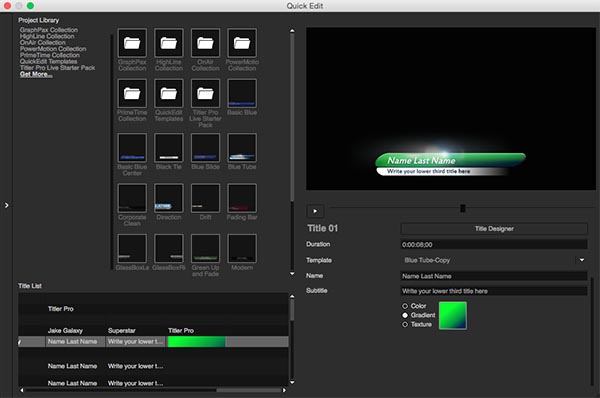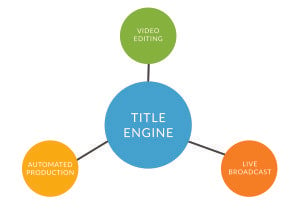
For many content creators, developing high-quality titles and graphics can be a real pain. There’s never been much money to be made in the process and yet, having great looking titles and graphics that pop are an integral part of the creative process. Each year, the quality bar gets raised and clients demand more. As we continue to witness the extraordinary explosion in the number of devices that are capable of playing rich media, content owners have to keep pace with their ability to bring compelling visuals to the broadest range of platforms. Creating rich, animated, high-resolution titles and graphics from offline, to online, to live broadcast, to the multitude of uniquely branded versions necessary for distribution, demands a strategy that involves less human intervention.
Why Siloed Graphics Workflows Won’t Do
Most NLEs have an integrated titling tool, but they are often weak, lacking the aesthetic sophistication of features like animation and 3D required for today’s productions. To compete, many productions either hire a motion graphic artist with advanced tools or pressure editors to include high-quality titles as part of their service. While some editors are up to the task, many admit that telling a compelling story is a full-time job on its own, especially with the shortened production timescales that are today’s norm. It’s clear that siloed graphics workflows are no longer cost effective and, even if a production does have a budget for a talented motion graphic artist, once the overall style has been completed, it’s costly to rely on the artist to implement further changes.
Likewise, the days of rendering on a separate system, exporting .mov files for each title, transferring them between systems, importing them into the NLE of choice, and manually placing on the timeline, all as a ‘rinse and repeat’ process for each style change, is over.
As demand for local, regional, and platform variants of the same content increases, budgets, on the other hand, are not increasing proportionally. The exponential increase in distribution platforms has made the traditional job of a repackaging editor —who once tagged the end of a national car spot with each local dealer’s contact info— unmanageable. With hundreds of variants required for the same program or spot, this is not a job to wish on anyone.
What about titles created during a live broadcast? Frequently, segments of the broadcast shows are extracted for use in a post-produced program. Proprietary, integrated titling systems for live broadcasts, rarely —if ever— offer a way to bring the graphics over to an NLE based post production workflow. This leads to the painfully inefficient re-creation of titles in an attempt to avoid mismatched styles across mediums.
A Platform Solution
With all of these titling pain points, a solution is clearly required if postproduction and distribution organizations are to avoid a decline in revenue from increases in non-billable hours. The right solution must present video editors with a familiar and consistent timeline interface to reduce learning curves and speed workflows. A platform approach, which enables shared libraries and metadata across applications and operating systems, can break down barriers and remove graphic creation silos. More specifically, a titling platform should support all popular online, offline, live, and automated production systems.
In such an environment, title templates for a given show should only be created once. Any changes to a template should automatically ripple through the timeline with little to no human intervention. Likewise, titles generated during a live production, if originating from the same platform, should easily be repurposed at any stage of postproduction. Not only does this avoid the painful re-creation of titles on a system that may not have matching fonts or other elements, but also guarantees that the artistic design is maintained throughout.
When it comes to multi-platform deliverables, it has never been more important to have a common title engine embedded as part of an automated production process. In this way, complex 3D animated titles are no more  problematic than a plain white-on-black title was in previous generations. With literally hundreds of high-quality title variations potentially required of a given program or spot, automation, with no human intervention required, is the only reasonable solution for such repetitive, mundane tasks. Not only does this radically streamline the process and cut costs, it also removes the possibility for errors considerably.
problematic than a plain white-on-black title was in previous generations. With literally hundreds of high-quality title variations potentially required of a given program or spot, automation, with no human intervention required, is the only reasonable solution for such repetitive, mundane tasks. Not only does this radically streamline the process and cut costs, it also removes the possibility for errors considerably.
Titles that flow – A Comprehensive Strategy
When it comes to motion graphics and titles, it is no longer sufficient to simply choose an application by the types and styles of imagery it creates. Although each application may have unique looks and strengths, the most important consideration for a modern postproduction workflow is how efficiently the titles flow from the first offline cut, through finishing, to the final distributed version, in an increasingly diverse multi-platform world. Rich, animated, 3D, graphic material should no longer require a specialist to create and possibly recreate export, and import every time there is a stylistic change. And when titling live productions, it’s important that any post-produced segments not be stuck in ‘title-limbo’ without a cost-effective way to match looks and styles generated across multiple systems.
A comprehensive title and motion graphics strategy is essential to maximize efficiency at every step of a media production pipeline. By utilizing an automated system, such as Telestream’s Vantage with title creation powered by NewBlue’s Title Engine, high quality, high output distributed workflows become possible. Title templates created using NewBlue’s Titler Pro are simply imported directly into the Vantage Post Producer service for automatic title generation via the Title Engine. Similarly, using a product like NewBlue’s Titler Live during live production guarantees title compatibility when segments are lifted for postproduction. For example, a live broadcast created with NewTek’s Tricaster using Titler Live can share its graphics with Avid Media Composer ® and Grass Valley EDIUS ® since both NLEs ship with a copy of NewBlue’s Titler Pro.
At NewBlue, we understand today’s challenges and the importance of making every creative second count. That’s why we’ve developed a titling platform that addresses all of these needs and more. Not only does it drastically speed up tedious handoffs between the stages of production, it also saves organizations tremendous amounts of labor and associated costs all the while enabling editors to tell a better story.